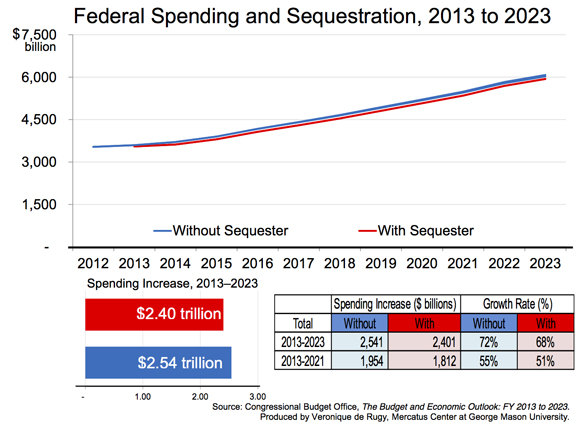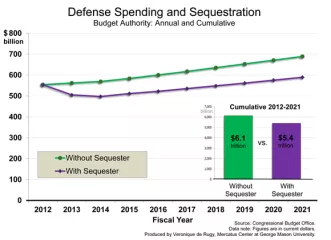- | Government Spending Government Spending
- | Data Visualizations Data Visualizations
- |
The Effects of Sequestration on Federal Spending
While the sequester is widely advertised as cutting spending over a ten year period, there is no actual reduction in overall spending levels. Rather, the sequester slows the overall growth in spending slightly between 2013 and 2023, with spending increasing by $2.40 trillion during that time period. Spending grows 51 percent, or $1.81 trillion, with sequestration between 2013 and 2021, the period when automatic spending procedures are to be enforced.
This chart uses the most recent Congressional Budget Office figures to show the effects of the sequester, or automatic spending reductions, on federal spending over the next ten years.
While the sequester is widely advertised as cutting spending over a ten year period, there is no actual reduction in overall spending levels. Rather, the sequester slows the overall growth in spending slightly between 2013 and 2023, with spending increasing by $2.40 trillion during that time period. Spending grows 51 percent, or $1.81 trillion, with sequestration between 2013 and 2021, the period when automatic spending procedures are to be enforced.
As we can see, federal spending would go up under sequestration. That’s mainly because the spending cuts heavily target the discretionary side of the budget, leaving programs like Social Security, Medicare and Medicaid (the main drivers of our future debt) almost untouched. As a result, the impact of sequestration on overall federal spending represents a small reduction in the growth of spending rather than an actual spending cut.
Data Notes:
The CBO outlines (in Table 1-1) its baseline, including the impact of sequestration. CBO’s Table 1-7 projects the budgetary impact of removing the effect of the automatic enforcement procedures specified in the BCA. We use the data from Table 1-7 to estimate spending without sequestration. While not perfect, it seems a reasonable assumption based on the statement by CBO that “discretionary outlays will drop by $35 billion and mandatory spending will be reduced by $9 billion this year as a direct result of [the sequester]; additional reductions in outlays attributable to the cuts in 2013 funding will occur in later years.” That’s a total of $44 billion for FY2013. Table 1-7 projects that repealing sequestration would add $42 billion to the debt in FY2013. The spending increases and growth rates were calculated relative to FY2012.
This is the most recently updated federal spending and sequestration chart given the February 5, 2013 release of the latest CBO data. On November 7, 2011, Mercatus Center senior research fellow Veronique de Rugy published a chart using data from CBO’s 2011 baseline to examine the estimated growth in spending without and with sequestration.



